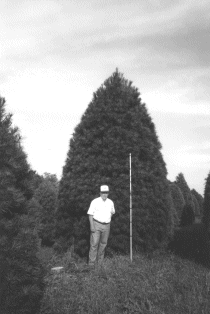There is a growing niche market for large Christmas trees. Older homes and some newly-constructed ones have either vaulted or cathedral ceilings that can accommodate trees considerably larger than the traditional average of 6 to 7 feet. These homes present a market that many growers may be missing, either because of the species they grow, the area of their plantation (it takes more land to grow a 12-foot tree than one only 6 feet tall), or because of the extra labor involved.
It is not uncommon for a homeowner with a large cathedral ceiling to want a tree from 14 to 16 feet tall even though it is more costly. There also are businesses, churches, banks, restaurants and a variety of other potential customers with similar demands.
Most growers in the Midwest rely heavily on Scotch pine. While Scotch pine, when properly manicured, makes a fine tree in the smaller sizes - up to 8 feet - most cultivars do not retain bottom branches well when getting into the larger sizes. A 9-foot tree, for example, will be thin at the bottom which is an undesirable trait for a Christmas tree. Spruces, Douglas fir, and the true firs in Missouri have shown limited success. Pines, however, are another possibility such eastern white, Austrian, or red (some folks refer to it as Norway pine).
Eastern white pine makes a beautiful tree, with the shape desired, and a dense crown if shearing commences at an early age. It has few disease and insect problems, although bagworms can sometimes warrant control. One of the major objections is that the branches tend to be rather flexible, and decorating with heavy ornaments can present a challenge. If placed in a good water-holding stand, which should be done with any tree, white pine retains its freshness well throughout the holiday season. This tree can be grown to about any size with good retention of the bottom branches.
Austrian pine has a rich, dark green color, stout branches, long stiff needles, and will support heavy ornaments. The crown will not be as dense as white pine, but the longer needles tend to make up for the smaller number of branches. There is one needle disease that attacks Austrian - dothistroma needle blight - that can be controlled. The trunk of the tree tends to be rather heavy, with heavier, less flexible branches than eastern white pine, so transporting trees of larger sizes can be more difficult.
Red pine is very similar to the Austrian pine. In fact, sometimes it is difficult to tell them apart. Branching habits are similar, needle length about the same, color very good, and they both retain their freshness well. Red pine does not appear to be susceptible to dothistroma, but the trees are very slow starters when planted from 2-0 seedlings. They are weak bud setters, often with no more than three buds formed at each cut branch.
Annual shearing of large trees is more time consuming. It can require pole-type shears, ladders if the ground is fairly level, and even mechanical support on the larger ones - such as trailers to serve as work platforms, front-end loaders, or scaffolds. Pricing of the trees must take into account the added effort and time required to produce trees of this size, but the market is there.
- Clell Solomon

Clell Solomon of Tannenbaum Farm, Armstrong, stands next to a 15-foot eastern white pine (measuring pole is 8 feet). Customers seeking large trees provide a niche market for Christmas tree producers.